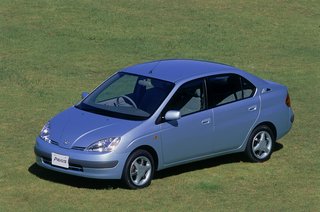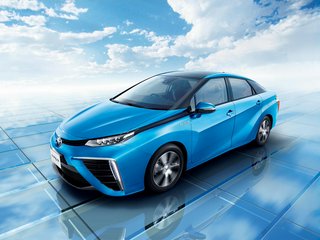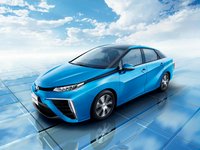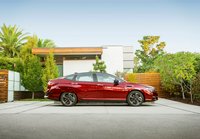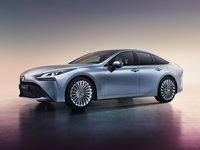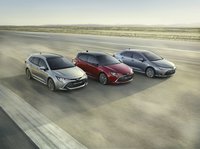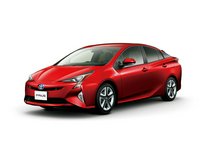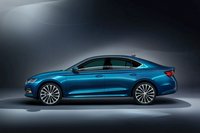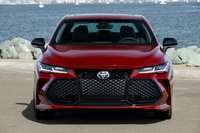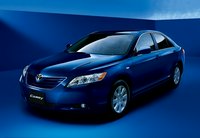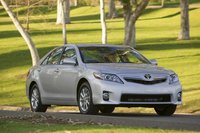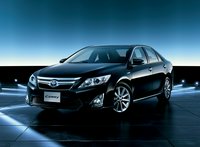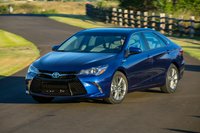Compare Toyota Prius XW10 vs Toyota Mirai
Capacity
Cargo Capacity
390 L / 13.8 cu-ft
361 L / 12.7 cu-ft
Coolant Capacity
4.9 L / 5.2 qt
Engine Oil Capacity
3.7 L / 3.9 qt
Fuel Capacity
50.0 L / 13.2 gal
Passengers
5
4
Payload
395 kg / 871 lbs
330 kg / 728 lbs
Chassis
Brakes | Front
Ventilated discs
Ventilated discs
Brakes | Rear
Drum
Disc
Power Steering
Electric Steering
Suspension | Front
MacPherson strut
MacPherson strut
Suspension | Rear
Torsion
Torsion
Tire Size
175/65 R14
255/55 R17
Turning Circle
11.3 m / 37.1 ft
Construction
Battery | Capacity
1.6 kWh (gross)
Body Style
4-door hybrid Sedan
4-door hydrogen fuel cell Sedan
Dimensions
Ground Clearance
130 mm / 5.1 in
Size | Height
1475 mm / 58.1 in
1535 mm / 60.4 in
Size | Length
4315 mm / 169.9 in
4890 mm / 192.5 in
Size | Width
1695 mm / 66.7 in | 1945 mm / 76.6 in (mirror unfolded)
1810 mm / 71.3 in
Track Width | Front
1475.0 mm / 58.1 in
1535.0 mm / 60.4 in
Track Width | Rear
1480.0 mm / 58.3 in
1545.0 mm / 60.8 in
Weight
1250.0 kg / 2755.8 lbs
1850.0 kg / 4078.6 lbs
Wheel Size
5.5J x 14
17 in
Wheelbase
2550 mm / 100.4 in
2780 mm / 109.4 in
Performance
Acceleration | 0 - 100 km/h
13.4 sec
9.6 sec
Acceleration | 0 - 60 mph
12.7 sec
9.1 sec
CO2 Emission
120 g/km
Coefficient Of Drag
0.29
Fuel Economy
5.1 L/100km / 46.1 MPG (combined) | 5.9 L/100km / 39.9 MPG (urban) | 4.6 L/100km / 51.1 MPG (highway)
Top Speed
160.0 km/h / 99.4 mph
175.0 km/h / 108.7 mph
Powertrain
Drivetrain Layout
Front-engine (transverse), Front-wheel drive
Front-wheel drive
Emission Standard
Euro 4
Engine
1NZ-FXE
Engine | Bore
75.0 mm / 3.0 in
Engine | Compression Ratio
13.0:1
Engine | Displacement
1.5 L / 91.4 cu-in / 1497.0 cc
Engine | Power
72.0 hp / 53.7 kW @ 4500 rpm + 44.0 hp / 32.8 kW (electric motor)
154 hp / 114.8 kW @ 6144 rpm
Engine | Specific Output
48.1 hp/L / 0.8 hp/cu-in
Engine | Stroke
84.7 mm / 3.3 in
Engine | Torque
115 Nm / 84.8 lb-ft @ 4200 rpm + 350 Nm / 258.1 lb-ft
Engine | Type
multi-port injected petrol inline-4 DOHC engine with 4 values per cylinder
hydrogen engine
Transmission | Type
e-CVT
e-CVT
Production
Availability
2000 ~ 2003
2014 ~ 2020
Reviews
Neofiliac score
10%
44%
Pros
- The world's first gasoline-hybrid vehicle
- The world's first fuel cell vehicle
- Powered by zero-emission hydrogen fuel cell
- Good 0.28 drag coefficient
Cons
- Horrible 0-100kph time
- Can't even reach 200km/h
- Miserably low engine output
- Stuck with MacPherson struts in the front
- Questionable styling
- Horrible 0-100kph time
- Can't even reach 200km/h
- Stuck with MacPherson struts in the front
- Poor handling characteristics
Remove
Remove
Add up to 4 products to the comparison using the search bar above
Information on this page is provided on an as-is basis. No warranty on accuracy is implied. This page may contain affiliate links to third-party merchants such as Amazon and eBay. If you make a purchase using the supplied link, we may receive a commission. Neofiliac places the utmost respect for your privacy. We use no cookie whatsoever beyond that needed for the proper functioning of the website.
